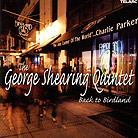September 2001
Might as well face it -- most of what we "know" about George Shearing is just plain wrong. It seems as if Shearing has been getting overlooked quite a bit during the bulk of his distinguished career. This in spite of a spate of big-selling records for both MGM and Capitol from 1950 – 1969. But the fact is that, were it not for Shearing and his many pioneering moves, jazz as we know it today might have a decidedly different sound and look. It was he who introduced Cal Tjader to the rhythms of South America. And he was one of the first to give a female (vibraphonist Marjorie Hymans) a featured role in a working quintet. Shearing's series of recordings for Telarc (of which Back To Birdland is the ninth) has forced the jazz world to reassess its opinion of the man's art. To my mind, Birdland is also one of Shearing's best recordings ever. He has gone back to the quintet style that won him so many fans earlier in his career -- vibraphonist Don Thompson, bassist Neil Swainson, guitarist Reg Schwager, and drummer Dennis Mackrel offer listeners a taste of past glories, while rewarding them with today’s superior sound. Shearing returns to the standards he loves and performs so well. But he doesn’t just limit himself and his group to slow ballads; he includes Charlie Parker’s "Donna Lee," Clifford Brown’s "Joy Spring," Lee Konitz’s "Subconscious Lee" and Duke Ellington’s "Drop Me Off In Harlem" in his repertoire. These tunes give Shearing and crew many chances to strut their stuff -- and it’s a treat to hear that Shearing, even at 81, still can ramp it up when the spirit moves him. His only concession to age is that he doesn’t do it as often, and he now allows his sidemen a larger share of the spotlight -- which is not necessarily a bad thing when you have musicians the caliber of the ones Shearing uses here. Swainson is the real standout: His bass playing holds everything together, and he has enough talent and confidence not to force himself upon the songs, but lets the music come to him. The sound mirrors the music. That is, it’s good for the most part, but not state of the art. The bass comes out best with deep, full sound and excellent definition. The cymbals shimmer believably, with only that last little smidgen of missing air keeping them from being among the best I’ve heard. The vibes sound resonates clearly. Unfortunately, it’s Shearing’s piano that suffers somewhat on this disc. While it has the appropriate size and heft, it’s a tad muffled, robbing the disc of its rightful centerpiece. And the drums also lack the some of the snap and sizzle of the real thing. Nevertheless, this is a Telarc disc, and the 20-bit recording (disappointingly not recorded in the DSD process that Telarc has put to such excellent use lately) offers far better than average sound. This live recording gives the listener a solid "U-R-there" feeling. In Shearing we have a jazz artist who has seen and heard it all. His influences range from boogie-woogie to stride to bebop, and he incorporates all of those distinct styles into one that sound just like...George Shearing. Shearing is one of a handful of jazz legends still giving us the benefit of their experience. (Dave Brubeck and Sonny Rollins also spring to mind.) Overlook George Shearing at your own risk. GO BACK TO: |
 George Shearing - Back to Birdland
George Shearing - Back to Birdland![[Reviewed on CD]](../format/regcd.gif) It's
common knowledge that George Shearing is the "original" West Coast cool-jazz
pianist. And everyone knows he’s just a glorified cocktail pianist. Say what?
He’s been recording and working mostly in New York City since he emigrated from his
native England? He also wrote the jazz anthem "Lullaby Of Birdland"?
It's
common knowledge that George Shearing is the "original" West Coast cool-jazz
pianist. And everyone knows he’s just a glorified cocktail pianist. Say what?
He’s been recording and working mostly in New York City since he emigrated from his
native England? He also wrote the jazz anthem "Lullaby Of Birdland"?